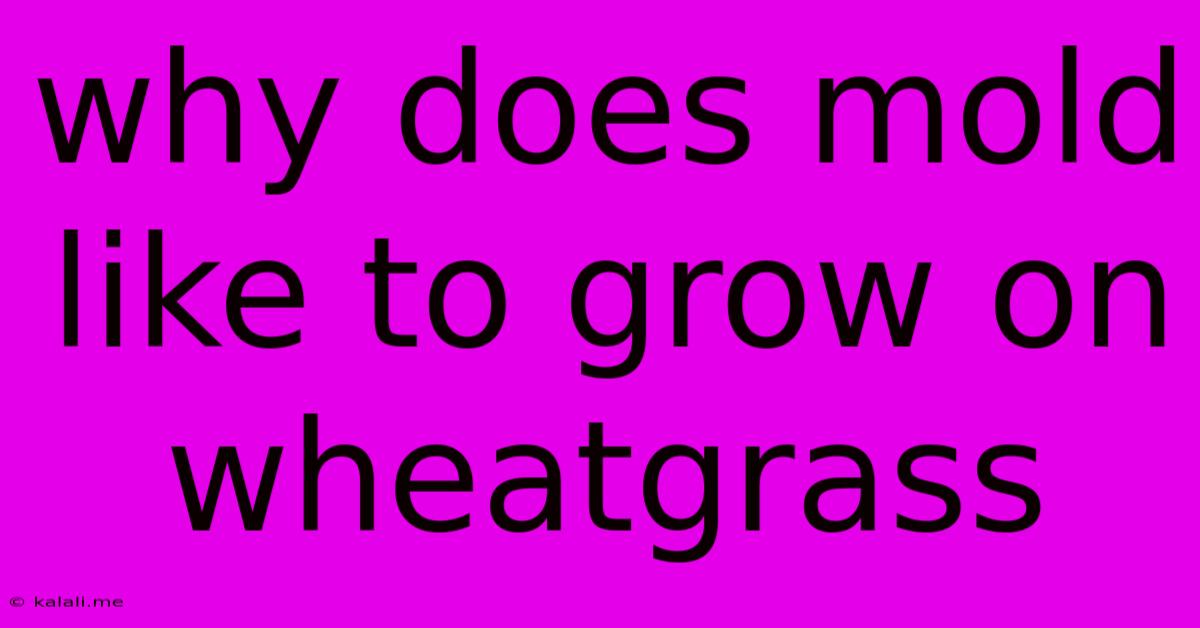Why Does Mold Like To Grow On Wheatgrass
Kalali
Jun 07, 2025 · 3 min read

Table of Contents
Why Does Mold Like to Grow on Wheatgrass? Understanding the Perfect Storm
Wheatgrass, while a nutritional powerhouse, is unfortunately a prime breeding ground for mold. This article delves into the reasons behind this susceptibility, exploring the environmental factors and inherent characteristics of wheatgrass that contribute to mold growth. Understanding these factors can help you mitigate mold contamination and ensure the safety of your wheatgrass.
Mold thrives in damp, dark, and nutrient-rich environments. Wheatgrass, with its high moisture content and abundant nutrients, ticks all these boxes, creating a perfect storm for mold proliferation. Let's break down the key reasons:
High Moisture Content: The Foundation of Mold Growth
Wheatgrass, by its very nature, is high in moisture. This abundance of water provides the essential element mold needs for growth and reproduction. Even slightly damp conditions are enough for various mold species to take hold and begin colonizing the plant. The process of sprouting and growing wheatgrass inherently involves managing moisture levels carefully. Any excess water can quickly lead to the development of mold.
Nutrient-Rich Environment: Fueling Fungal Growth
Wheatgrass is packed with nutrients – vitamins, minerals, and amino acids – making it a highly attractive food source for mold. These nutrients provide the energy and building blocks mold requires for rapid growth and propagation. The very qualities that make wheatgrass beneficial for humans also make it a tempting substrate for mold spores.
Ideal Temperature Range: Accelerating Mold Development
Mold spores are ubiquitous in the environment. They're present in the air, soil, and on surfaces. Wheatgrass, when grown in a warm and humid environment, provides an optimal temperature range for many mold species to germinate and multiply quickly. Temperatures between 68-86°F (20-30°C) are particularly favorable for mold growth. This is often the temperature range in which wheatgrass thrives, unintentionally creating ideal conditions for mold contamination.
Lack of Air Circulation: Stagnation Leads to Mold
Poor air circulation around your wheatgrass can lead to increased humidity and reduced evaporation. This creates stagnant conditions which are perfect for mold development. Adequate air circulation helps maintain a drier environment, reducing the risk of mold growth. This is particularly crucial when growing wheatgrass indoors, where ventilation might be limited.
Spore Contamination: The Initial Infection
Mold spores are constantly floating in the air. These spores can easily land on your wheatgrass and, under the right conditions, germinate and begin to grow. Poor hygiene practices during harvesting, handling, and storage can further increase the risk of spore contamination. Even seemingly clean equipment can harbor spores, leading to future infections.
How to Minimize Mold Growth on Your Wheatgrass
- Ensure proper drainage: Avoid overwatering to minimize moisture buildup.
- Maximize air circulation: Provide adequate ventilation to prevent humidity.
- Maintain cleanliness: Keep your growing area and equipment clean to minimize spore contamination.
- Proper harvesting and storage: Harvest wheatgrass at the appropriate stage and store it in a cool, dry, and well-ventilated area.
By understanding the factors that contribute to mold growth on wheatgrass, you can take proactive steps to prevent contamination and enjoy the benefits of this healthy superfood safely. Remember, prevention is always the best strategy when it comes to dealing with mold.
Latest Posts
Latest Posts
-
How To Fix Cracked Leather Car Seats
Jun 07, 2025
-
How Did Rukia Have A Hogiyoku
Jun 07, 2025
-
How To Open Menu In Pokemon Black 2 Mobile Emu
Jun 07, 2025
-
Hjow Auto Snap In Blender Array
Jun 07, 2025
-
A Volkswagen Karmann Ghia Has No Radiator
Jun 07, 2025
Related Post
Thank you for visiting our website which covers about Why Does Mold Like To Grow On Wheatgrass . We hope the information provided has been useful to you. Feel free to contact us if you have any questions or need further assistance. See you next time and don't miss to bookmark.